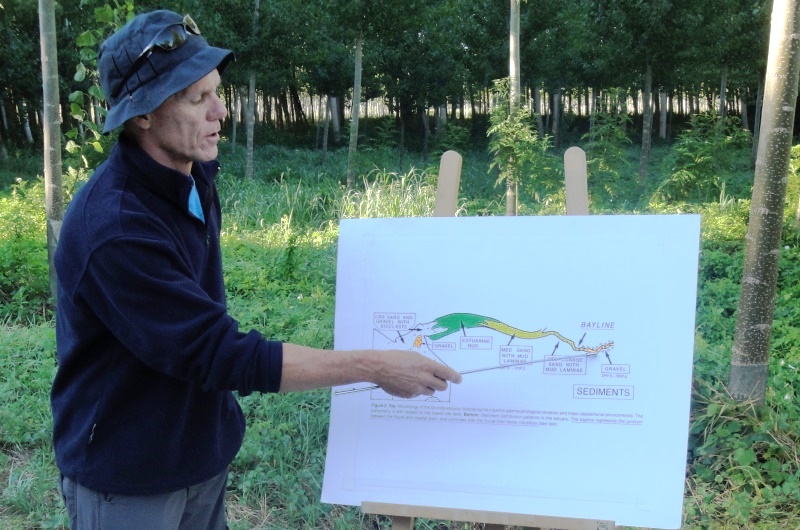Course Details
Home / Public Courses / Course Details
Integrated Reservoir Geology Field Trip: Reservoir Characterisation of Fluvial, Estuarine & Deltaic Deposits in Modern and Ancient Environments, SW France & Spanish Pyrenees (FTP09)
Description
This training presents reservoirs deposited in modern and ancient fluvial, estuarine and deltaic environments, with an applied production geology exercise (data base: fluvial reservoirs of a Cretaceous oil field - SW France).
Duration of the training: 5 days, location: SW France + Spain:
- Field work in the modern EOD takes place in SW France (Bordeaux area)
- Field work in the ancient EOD takes place in the Spanish Pyrenees (Serraduy-Tremp area)
Course Level: Skill
Duration: 5 days
Instructor: Hugues Fenies
Duration of the training: 5 days, location: SW France + Spain:
- Field work in the modern EOD takes place in SW France (Bordeaux area)
- Field work in the ancient EOD takes place in the Spanish Pyrenees (Serraduy-Tremp area)
Course Level: Skill
Duration: 5 days
Instructor: Hugues Fenies

Designed for you, if you are...
- An exploration or production geologist/geophysicist working on fluvial/estuarine/deltaic reservoirs
- A reservoir engineer in charge of modelling and producing these reservoirs
Physical Demands
The physical demands of this course are low. Field walks will be slow and field sessions will not last more than a couple of hours. You will be walking in water (water depth: 1 - 2 feet) and on muddy soils. Some transfers are by boat within the channels of the Gironde estuary and the Arcachon lagoon.
In the Pyrenees there will be short hikes.
How we build your confidence
- Field guide books
- Power Point Presentations
- Poster sessions (before and after each field stop)
- Core descriptions (high-quality cores, preserved in epoxy)
- Very High Resolution Seismic lines (Seistec & Sparker)
- Cretaceous oil field data (core pictures, well logs correlation panel)
The benefits from attending
This field trip is a unique opportunity to:(i) visualise the modern-day environments of deposition and the associated reservoir geobodies,
(ii) compare the modern deposits to their Eocene reservoir analogs and analyse their spatial distribution within a sequence strat. framework,
(iii) understand the best way to produce these reservoirs with a real-live business-case Cretaceous oil field exercise (fluvial & estuarine reservoirs).
The aims of this training are to examine:
- Detailed facies analysis of shallow marine depositional environments: fluvial – estuarine - deltaic
- Reservoir characterisation of the sand bodies deposited in these environments: geometries, internal heterogeneities, interconnections
- Sequence stratigraphic analysis of the large scale reservoir architecture: spatial distribution of reservoirs and seals, potential stratigraphic traps analysis
- Direct application of these field concepts to a business case study: a Cretaceous oil field exercise, with reservoir characterisation (sedimentology of fluvial & estuarine Sst.), reconstruction of reservoir architecture (sequence stratigraphy & reservoir layering) and presentation of guidelines for production optimisation
Topics
Day 1: Modern-day deposits of the Garonne river & Gironde estuary (tide-dominated) / SW France- Introductory lecture presenting the depositional environments of the Aquitaine basin
- Fluvial meandering channels with sandy-conglomeratic point bars
- Estuarine meandering channels, with heterolithic point bars (core)
- Estuary-funnel sandy tidal bars (cores and very high resolution seismic)
- Internal architecture of the estuarine bay-head delta: reservoirs and internal seals
- Sequence stratigraphic model and reservoir architecture of the tide-dominated Gironde incised (very high resolution seismic)
Day 2: Modern-day deposits of the Arcachon estuary (wave-dominated) / SW France
- Inner estuary meandering sandy tidal channels and muddy tidal flats (cores and very high resolution seismic)
- Outer tidal inlet channel-fill and sandy tidal flat
- Sequence stratigraphic model and reservoir architecture of the wave-dominated Arcachon incised valley (very high resolution seismic)
- Comparison with the tide-dominated Gironde incised valley
Day 3: Eocene deltaic Roda Sandstone (flood-dominated) / Southern Pyrenees; Spain
- Introduction to basin setting: the Eocene Roda Sandstone is composed of six fluvio-deltaic sequences, which infilled a piggy-back basin located in the foreland of the Southern Pyrenees
- Flood-dominated Gilbert delta lobes, facies, reservoir architecture and sequence stratigraphy
Day 4: Eocene deltaic Roda Sandstone (tide-dominated) / Southern Pyrenees; Spain
- Tidal dunes and tidal bars deposited at the base of the Gilbert delta foresets, under the influence of tidal currents: facies, reservoir architecture and sequence stratigraphy
Day 5: Eocene fluvial Castissent Sst./Southern Pyrenees; Spain & Cretaceous oil field exercise
- Braided streams & meandering channels: facies, reservoir architecture and sequence stratigraphy
- Direct application of the field concepts to a business case study: a Cretaceous oil field exercise, with reconstruction of reservoir characterisation & architecture, thanks to sedimentology and sequence stratigraphy and presentation of guidelines for production optimisation
The course fee includes daily transportation for field visits, local accommodation (6 nights) and full board on course days. For further details please contact training@hoteng.com
Related Courses
- Shallow Water Reservoir Characterisation in the Modern-Day Environments of the Gironde Estuary and Aquitaine Basin / SW France (FTP02)
- North Atlantic Margin Petroleum Systems / Morocco (FTP06)
- Structural Geology, Stratigraphic Architecture and Trap Styles of Sicily FTB - A Multidisciplinary Approach on the Field / Sicily, Italy (FTP07)
- Carbonate Reservoir Characterisation on the Field / Sicily, Italy (FTP08)
© All rights reserved
HOT Engineering GmbH Tel: +43 3842 43 0 53-0 Fax +43 3842 43 0 53-1 hot@hoteng.com
